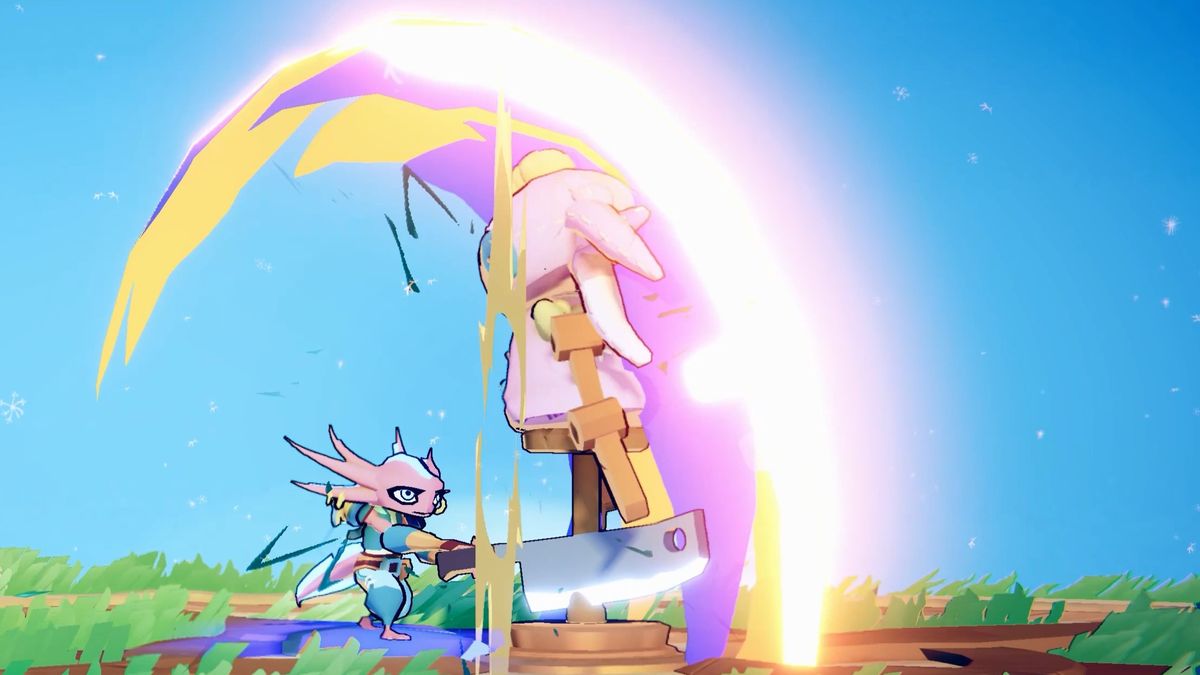
Developers from Motion Twin, best known for incredibly popular roguelite Dead Cells, are in on the joke when they talk about the process of making their new game meaning they had to throw away tons of progress and start over. “We fail all the time. We’re like, OK, what we did is pure shit, let’s try again. It’s a roguelite production,” said designer Yannick Berthier, as he walked me through Motion Twin’s new action game Windblown.
The studio’s first new project since Dead Cells is also a roguelite—art truly imitates life, I guess—that plays substantially faster than their previous 2D action, with an incredibly zippy dash move key to staying alive in the now-3D combat environments. Also key to combat is the weapon system, which lets you swap between two weapons on the fly to combo attacks into unique finishers. “Every weapon has a hidden, super powerful attack that can only be triggered by playing with the other weapon equipped,” said Berthier.
Motion Twin artist Thomas Vasseur, who was driving the demo, chimed in to elaborate. “The goal for us is to have a lot of synergies between weapons, so every time you unlock a weapon you’ll have to think about how it will work with another one.” For example, some weapons can reach the end of a combo string very quickly, so you can more quickly unleash the special technique, called an “alter attack” from your second weapon—perhaps a heavier greatsword that would’ve normally taken longer to get up to speed.
Different weapons will trigger the alter attack of their partner in different ways. The shield, for example, doesn’t activate its alter attack by doing damage, but when you take damage you can parry and then immediately trigger an alter attack… if you’re good enough. Windblown’s reaction timings look tight, and learning the game clearly isn’t going to require just mastering how the weapons play, but how they affect one another. There are currently 11 weapons in the game, and the system looks so polished that I was shocked when Berthier volunteered the fact that a few months ago, it hadn’t existed at all.
“On the Steam page it says five, because we had a completely different system for the weapons. Two weeks ahead of the announcement we removed everything and redid the whole design,” he said.
I barely got the obvious question—why—out of my mouth when Vasseur jumped in. “Because it was booooring!” he said, laughing.
“That’s the short answer, Berthier said. “The slightly longer one is that it was great for a linear game, but not a roguelite. It didn’t push enough for diversity.” Motion Twin had spent two years designing Windblown’s combat system when they decided to rip it out, and designed something new in just three weeks. But the core idea arrived even more quickly than that—they knew they were onto something the very first day, Berthier said. The big giveaway?
Pretty straightforward, it turns out: “It was fun.”
Windblown didn’t actually start life as a roguelite: Motion Twin’s goal was to make a high-speed action game that could be played with friends, and the roguelite structure eventually proved to be the answer to making that format work, and avoiding the natural power imbalance that would come from someone with 100 hours in the game partying up with a friend just getting started. So early on many playtesters loved being able to stick with one weapon and use it over and over again, but only up to a point. After a few roguelite runs of those weapons being static, they’d simply get bored and quit the game.
Once Motion Twin changed to the system that emphasized swapping between weapons to trigger unique ultimates, the variety they were looking for emerged.
“We saw that people wanted to theorycraft. We already knew that having two weapons worked, because it’s something that exists in Dead Cells,” Berthier said. “So we thought again, okay, let’s start again with that base idea. But if we want synergies, the best way to do it is require the player to do something to unleash the power of another thing. The idea was found in like two days, but sometimes we struggle for two years.”
“Failing is part of the process,” said Vasseur. “We need to be able to dare to kill a feature when it does not work or reach the goal. It’s a bit stressful, but rewarding at the end when you find the right formula.”
You’ve gotta respect that honesty—and from what I’ve seen, Motion Twin’s willingness to fail and try, try again is paying off in Windblown, which looks both fun and brutally hard. Check out my full write-up for more from our first look at Motion Twin’s second roguelite.
- SEO Powered Content & PR Distribution. Get Amplified Today.
- PlatoData.Network Vertical Generative Ai. Empower Yourself. Access Here.
- PlatoAiStream. Web3 Intelligence. Knowledge Amplified. Access Here.
- PlatoESG. Carbon, CleanTech, Energy, Environment, Solar, Waste Management. Access Here.
- PlatoHealth. Biotech and Clinical Trials Intelligence. Access Here.
- Source: https://www.pcgamer.com/games/roguelike/for-their-new-roguelite-the-dead-cells-team-scrapped-2-years-of-work-on-combat-and-redid-it-in-just-3-weeks-we-need-to-be-able-to-dare-to-kill-a-feature-when-it-doesnt-work



